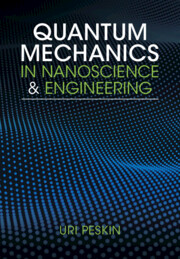Book contents
- Quantum Mechanics in Nanoscience and Engineering
- Additional material
- Quantum Mechanics in Nanoscience and Engineering
- Copyright page
- Contents
- Preface: Who Can Benefit from Reading This Book?
- 1 Motivation
- 2 The State of a System
- 3 Observables and Operators
- 4 The Schrödinger Equation
- 5 Energy Quantization
- 6 Wave Function Penetration, Tunneling, and Quantum Wells
- 7 The Continuous Spectrum and Scattering States
- 8 Mechanical Vibrations and the Harmonic Oscillator Model
- 9 Two-Body Rotation and Angular Momentum
- 10 The Hydrogen-Like Atom
- 11 The Postulates of Quantum Mechanics
- 12 Approximation Methods
- 13 Many-Electron Systems
- 14 Many-Atom Systems
- 15 Quantum Dynamics
- 16 Incoherent States
- 17 Quantum Rate Processes
- 18 Thermal Rates in a Bosonic Environment
- 19 Open Quantum Systems
- 20 Open Many-Fermion Systems
- Index
- References
1 - Motivation
Published online by Cambridge University Press: 11 May 2023
- Quantum Mechanics in Nanoscience and Engineering
- Additional material
- Quantum Mechanics in Nanoscience and Engineering
- Copyright page
- Contents
- Preface: Who Can Benefit from Reading This Book?
- 1 Motivation
- 2 The State of a System
- 3 Observables and Operators
- 4 The Schrödinger Equation
- 5 Energy Quantization
- 6 Wave Function Penetration, Tunneling, and Quantum Wells
- 7 The Continuous Spectrum and Scattering States
- 8 Mechanical Vibrations and the Harmonic Oscillator Model
- 9 Two-Body Rotation and Angular Momentum
- 10 The Hydrogen-Like Atom
- 11 The Postulates of Quantum Mechanics
- 12 Approximation Methods
- 13 Many-Electron Systems
- 14 Many-Atom Systems
- 15 Quantum Dynamics
- 16 Incoherent States
- 17 Quantum Rate Processes
- 18 Thermal Rates in a Bosonic Environment
- 19 Open Quantum Systems
- 20 Open Many-Fermion Systems
- Index
- References
Summary
We discuss the breakdown of classical theory in relation to phenomena on the nanoscale. The historical discovery of the wave nature of electrons in the Davisson–Germer Experiment is reviewed. We present the puzzling experimental data and its explanation in terms of particle diffraction, which contradicts classical mechanics. The quantitative success of de Broglie’s formula in associating particle momenta with a wavelength is demonstrated. Analyzing the conditions in which the wave nature of particles becomes apparent, namely, the condition for correspondence between the de Broglie wavelength and the lattice from which the particles are diffracted, we draw some general conclusions. Particularly, by translating to de Broglie wavelengths the particle masses and energy values that are typical to materials and processes on the nanoscales, one immediately realizes that wave properties are expected to be dominant. Quantum mechanics is therefore essential for a proper description of nanoscale phenomena.
Keywords
- Type
- Chapter
- Information
- Quantum Mechanics in Nanoscience and Engineering , pp. 1 - 4Publisher: Cambridge University PressPrint publication year: 2023

